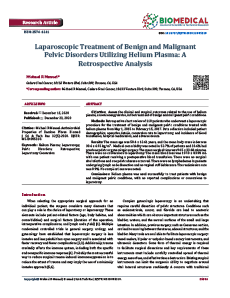Laparoscopic Treatment of Benign and Malignant Pelvic Disorders Utilizing Helium Plasma: A Retrospective Analysis
ITEM TYPE:
Journal Article
AUTHORS:
Michael R. Manuel
ABSTRACT:
Objective: Assess the clinical and surgical outcomes related to the use of helium plasma, a novel energy device, in the treatment of benign and malignant pelvic conditions.
Methods: Retrospective chart review of 110 patients who underwent a laparoscopic procedure for the treatment of benign and malignant pelvic conditions treated with helium plasma from May 1, 2015 to February 15, 2017. Data collection included patient demographics, operative details, conversion rate to laparotomy, and incidence of blood transfusion, hospital readmission, and adverse events.
Results: The mean age was 50.4 ± 12.61 years, and the mean body mass index was 30.6 ± 6.95 kg/m². Medical comorbidity was noted in 52.7% of patients and 33.6% had previous pelvic or gynecologic surgery. The mean surgical time was 94.5 ± 33.68 minutes. There were no conversions to laparotomy. The mean blood loss was 107.0 ± 83.98 mL with one patient receiving a postoperative blood transfusion. There were no surgical site infections and one pelvic abscess occurred. There were no lymphedemas in patients undergoing lymph node dissection and no vaginal cuff dehiscence. The readmission rate was 0.9%. No complications were noted.
Conclusions: Helium plasma was used successfully to treat patients with benign and malignant pelvic conditions, with no reported complications or conversions to laparotomy.
APYX® MEDICAL DISCLOSURES:
FINANCIAL & CONTENT DISCLOSURE
Apyx Medical provided funding for this study and literature. The opinions contained herein are those of the authors(s) and do not necessarily represent the official position or policies of Apyx Medical, Inc.
MANUFACTURING DISCLOSURE
Apyx Medical manufactures and owns the Renuvion®/J-Plasma® technology discussed in this article.
INDICATIONS FOR USE & INTENDED USE DISCLOSURES
- The Renuvion Precise, Precise Open, and J-Plasma Handpieces are intended to be used with compatible electrosurgical generators for the delivery of radiofrequency energy and/or helium plasma for cutting, coagulation, and ablation of soft tissue during open surgical procedures.
- Apyx Medical wants to present to you with current scientific discourse.
RISKS
- Risk associated with the use of the device may include: Helium embolism into the surgical site due to inadvertent introduction into the venous or arterial blood supply system, unintended burns (deep or superficial), pneumothorax, temporary or permanent nerve injury, ischemia, fibrosis, infection, pain, discomfort, gas buildup resulting in temporary and transient crepitus or pain, bleeding, hematoma, seroma, subcutaneous induration, pigmentation changes, increased healing time, and/or unsatisfactory scarring. There may be additional risks associated with the use of other devices along with Renuvion/J-Plasma and there may be an increased risk for patients who have undergone prior surgical or aesthetic procedures in the treatment area.
As with any procedure, individual results may vary. As with all energy devices there are inherent risks associated with its use, refer to the IFU for further information.



